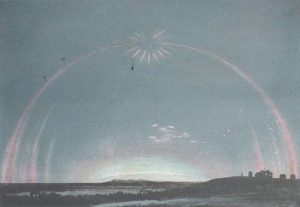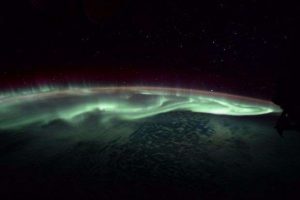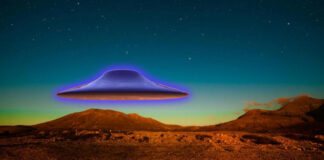MARCH 24, 2019
 An illustration of the view from Melbourne during the Carrington Event.
An illustration of the view from Melbourne during the Carrington Event.
The tail end of a solar storm that erupted from the sun earlier this week is expected to smash into Earth’s magnetic field this weekend, making the aurora borealis (also known as the northern lights) visible as far south as Chicago.
It’s the first bit of exciting space weather we’ve had in many months as we’re in the calm period at the end of the current 11-year solar cycle. The smallish solar flare and associated coronal mass ejection that erupted Wednesday also pale in comparison with far stronger and more disruptive blasts that have hit us in the past and almost certainly will again in the future.
Perhaps the most famous magnetic storm is the so-called “Carrington Event” in 1859. The storm came at the dawn of our modern technological era and all but knocked the young telegraph system out of commission temporarily while lighting up skies with colorful aurora as far south as current-day Belize and Thailand.
Recently, an international team of researchers pored over many of the observations of the solar storms of 1859 to try to reconstruct the details. The resulting paper, published in The Astrophysical Journal, is loaded with otherworldly anecdotes.
“At 10.26 p.m. (on Sept. 2) the light of stars of the third and fourth magnitude very much enfeebled,” wrote George Neumayer, director of Australia’s Melbourne Flagstaff Observatory, in 1864. “Beautiful rays through Pisces. During the last 10 or 15 minutes a beautiful red arc of light, extending from E. to W., and passing through the crown, had become almost stationary.”
 One report from Puerto Rico described “luminous rays, red, purple and violet, extended even to the zenith” and another from central Mexico mentioned “a silver lily in the shape of an arc of a great circle (from the region of the sky where) glowing rays extended downwards as if to meet a red light that shone up from the northern horizon.”
One report from Puerto Rico described “luminous rays, red, purple and violet, extended even to the zenith” and another from central Mexico mentioned “a silver lily in the shape of an arc of a great circle (from the region of the sky where) glowing rays extended downwards as if to meet a red light that shone up from the northern horizon.”
While most of the activity from the solar storm was reported on Sept. 1 and 2 in 1859, the sun was actually hyperactive from Aug. 28 to Sept. 4. It must have been one heck of a week. Remarkably, there are reports of aurora sightings even closer to the equator than what most accounts of the event say — as far south as Panama.
There were widespread reports of glitches with telegraph transmissions and even of electrical shocks and fires started by telegraph wires overwhelmed by the invisible attack from our star.
Imagining what a Carrington-level event would do to today’s highly intertwined and critical electrical infrastructure has been the subject of a great degree of worry, and for good reason.
We’ve seen powerful solar storms in the modern era. Most recently, an X-class solar flare killed a satellite and caused a 12-hour blackout in parts of the northern US and Ontario on Halloween in 2003. That was the strongest directly measured flare so far. Another in 1989 caused a long blackout in Quebec, messed with sensors on the space shuttle and caused a mini-panic that a nuclear attack might be underway. Still, the power of the 1859 event likely dwarfs these more recent storms.
But it turns out the Carrington Event might not even mark the far end of the spectrum for how intense a solar storm can get.
Earlier this month, a report appeared in Proceedings of the National Academy of Sciences saying it has evidence of a solar storm around 660 B.C. which, along with a previously known event in 775 A.D., is likely to have been far stronger still.
Both events could have been 10 to 20 times more powerful than the Carrington Event that lit up the globe with aurora and disabled communications.
In other words, although the sample size is very small, history seems to tell us to expect a mega solar storm about once per millennium. And if the Carrington Event wasn’t the big one for the past thousand years, as the data also seems to show, we’re actually far overdue for a massive blast from the sun.










































































































